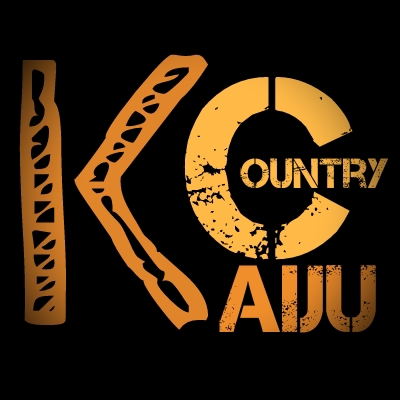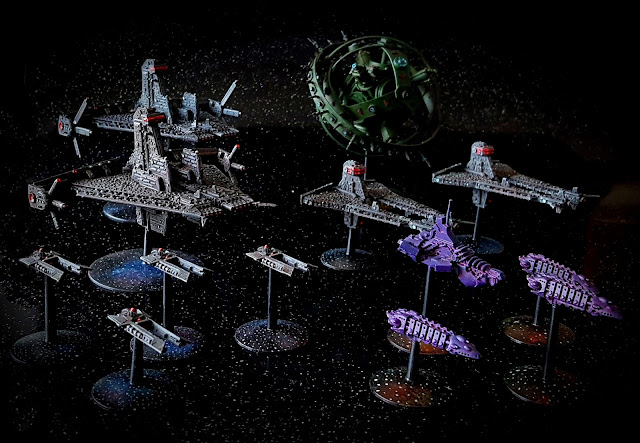Defending the Empire
 |
| My Kor'vattra fleet with auxiliaries |
Battlefleet gothic is a game system I dearly love and would say that although, broadly speaking it has more complex mechanics, I prefer it to other fleet based games such as Star Wars Armada. The main reason for this is that it has a lot more variation, particularly with obstacles, the effects of gravity wells etc. It's not a perfect game system and definitely has some balance issues (I'm looking at you Necrons...), but on the whole, it's amazing for creating narrative campaigns and special missions. Planetary invasions / defences in particular are a blast!
Recently I decided to dust off my old Battlefleet gothic Tau Fleet which has been in storage for a number of years. The models themselves were in good repair, but I decided to improve their original paint jobs (as my skills as a painter have improved since I originally did them) and paint their bases which gas clouds and stars rather than just having them plain black.
In total, my Tau fleets (the Forgeworld Kor'vattra ships, the Specialist Games Explorer fleet, all of my alien auxiliaries and defence platforms) total 97 miniatures. That doesn't sound like much until you realise that a decent sized game of BFG normally involves about 10 ships per side!
The ships I'll be showing today are from the Kor'vattra protection fleet and are in my opinion some of the absolute best ship designs not only in this game, but in any game system. They have a grace and flow to the designs which really set them apart from the ships of other races; instantly recognisable from their silhouettes.
While the Explorer fleets tend to focus mainly on ordnance domination with huge numbers of fighters, bombers, drone guided torpedoes and masses of turrets to reduce the impact of any enemy ordnance, the Kor'vattra fleet is a much more resilient in a stand up fight, with a nice range of weaponry allowing for a broader array of tactical options than just disgorging waves of ordnance. The Kor'vattra fleet in particular focuses all of its weapons arrays to the fore, creating a deadly kill zone in front of your ships, allowing for deadly alpha strikes rather than strafing broadsides like their imperial equivalents. Being able to loose batteries, lances and torpedoes on an enemy battleship from multiple squadrons can be devastating!
The Kor'vattra Fleet
I still have a handful of Kor'vattra ships to complete, but the majority of them have been freshened up and photographed for your viewing pleasure!
 |
| The majority of my Kor'Vattra ships - I still have another Custodian, two more Protectors and eight Wardens to finish off before I move on to the merchant fleet and defences |
The Forgeworld ships were the first ones I bought when starting my fledgling battlefleet - I started off with just two Protectors, but quickly added more and more ships to the fleet. I found them fun to use although I did have a tendency to create unwanted pile-ups with poor manoeuvring!
 |
| The fleet preparing to make a system jump |
Custodian Battleships
 |
| My Custodian Flagship, The Ulysses with its three dedicated Warden escorts |
One limitation of this fleet is that you can only take warden gunships up to the capacity of grav hooks in your fleet. Each custodian has three hooks, so you rarely find yourself without a decent compliment of escorts.
 |
| Each of my Custodians is painted with a unique colour scheme as are their matching Wardens |
 |
| The Agamemnon was actually the first Custodian I bought and painted. It's a veteran of many battles |
 |
| I quickly lost count of the number of times its accompanying Warden Gunships were destroyed! |
 |
| The Heracles Revenant and its Warden escorts were painted with the film Tron in mind |
 |
| I was especially pleased with the dust clouds on these bases |
 |
| The Ghost of Honour is painted in a 'stealth pattern' |
 |
| The paint scheme grants the ability to look bad ass! |
Protector Cruisers
 |
| My first set of Protector Cruisers, the Strike Freedom and the Infinite Justice. I was watching a lot of Gundam at the time! |
 |
| Rocking the signature paint scheme of my fleet, these stalwart defenders have seen off many enemy fleets as well as once being pulled into a black hole while fighting Necrons. Don't ask... :( |
 |
| The Sabre and the Rapier; another pair of solid ships which have seen a large number of engagements! |
 |
| I liked the idea of opposite paint schemes on this pair of protectors |
Protector cruisers work well together in pairs - individually I found that they tend to get picked apart by escorts because of their limited capacity for tanking damage, but in pairs, they are more than capable of punching through an escort formation or tag teaming and crippling a cruiser.
 |
| The Photronic and the Electross have different bridges to the other Protectors in the fleet. I like a little variation in my ship designs as they won't all have been constructed in the same shipyards |
 |
| This pair of Protectors sport the same 'stealth' paint scheme as the Ghost of Honour - they are clearly part of the same battlegroup! |
Emissary Light Cruisers
 |
| Despite their size, two Emissaries can still threaten an enemy flank or hide in a dust cloud and snipe with guided torpedoes! |
 |
| My third Emissary, the Foil is painted again painted with the stealth scheme and sports a different bridge tower to the standard Emissaries |
Castellan Escorts
 |
| The colour schemes and bases of my two Castellan squadrons make it easy to work out which group they are in |
 |
| As with some of my other ships, these four Castellans got the stealth scheme to set them apart from their sister squadron |
Courier Transport ships
Alien Auxiliaries
In addition to the core Tau fleet, I have also dusted down and tarted up my alien auxiliaries. Although they are allies rather than part of the core fleet, the range of alien races available to the Tau add a little flavour (and unpredictability) to the fleet overall.
Kroot Warsphere
I scratch built my Kroot Warsphere as I'd decided that I wanted it to look more like a constantly spinning ball of gyroscopic hoops than a large solid block like the official metal miniature. I still love the design even though I could probably have executed it better now that my scratch building skills have improved!
This is the largest battleship class of Kroot Warsphere (they're all effectively the same, just with more or less batteries and hull points). I decided I was only ever going to make one Warsphere as although it's fun to use one, they're not viable as a staple warship in your fleet.
The main reasons for this inflexibility are:
1). It only has batteries, so its firepower can be easily reduced by obstacles, range or the enemy ship's facing
2). It is so slow and ponderous that it always counts as stationary so can take devastating amounts of damage from other battleships
3). It's renowned for being one of the most annoying ships in the game to manoeuvre as you can only change your facing if you move on all ahead full orders and roll 10+ on 2D6. As such, almost every game I played with the Warsphere ended with it shuffling off the opposite end of the board having not made a single successful turn all game...
 |
| Kroot Warsphere; The Carrion Lord |
Nicassar
The Nicassar are a minor auxiliary race who don't fulfil a particular niche in the Tau force outside of being able to make a 180 degree turn. Were they better armed, Nicassar Dhow escorts might have played an important part in flanking strategies, but as they only have a modest battery armament, I often just used them to slow down enemy ships by causing shield flares or intercepting ordnance in place of more important ships.
In a similar fashion to Warden gunships, the Nicassar Dhows require a 'transport' to hop between systems. Instead of being attached to a battleship though, the Nicassar travel the galaxy strapped together on a rig, only detaching the individual ships when they need to move independently, such as when they are needed to stop a large torpedo salvo with their fragile hull or inconvenience a battleship as above. The rig itself is an immobile platform which is effectively a small bunch of floating victory points for your opponent. It can't shoot and your opponent will probably ignore it in favour of literally any other target, so in game terms, it may as well be a floating space turd for all the difference it makes!
As the metal Nicassar Dhow model had been out of print for some time when I started playing BFG, I had to come up with an alternative for them. I ended up converting some Forgeworld Eldar transport ships to make the escorts, and some parts from my bits box to produce their pointless junk trailer. I mean rig. Ahem.
 |
| My 3 Dhow escorts and their interstellar caravan |
Demiurg
The Demiurg crew enormous mining vessels which fight alongside the Tau Empire when called upon. My Demiurg contingent consists of three ship classes; the gigantic Stronghold Battleship, the Bastion Cruiser and the Trident Escort.
When I originally built my Demiurg ships, I decided that I didn't like the way which they were meant to function, so swapped the central section around so that the ships actually move in the opposite direction to the traditional design. This makes my Demiurg fly the same way as a Star Destroyer which I found a lot more pleasing that the original versions.
The Stronghold battleship is an absolute beast being armed with batteries, ordnance and a short ranged but horrifically powerful forward facing mining laser which can cripple an unshielded battleship in a single salvo. The main downside of these ships is the fact that they are about as fast and manoeuvrable as a tortoise encased in a block of concrete. They're great for facing down other slow battleships, but are generally given a wide berth by the enemy...
The Bastion cruiser is a decent ship with similar attributes to its Stronghold papa. They work well as a mid range brawler, but due to their mercenary status, most scenarios see them crippled and jumping out of the battle when you really need them the most!
The Trident escort models were part of a pack of metal Rogue Trader ships which Games Workshop produced - I thought they looked perfect with my other Demiurg ships so created rules for them using an article from the Citadel Journal (I think?) which ended up with them being roughly the equivalent of an Imperial Firestorm Frigate.
Every Fleet needs a Commander...
Finally, my fleet wouldn't be complete without an Admiral to bark commands from his flagship! I generally just use these miniatures to indicate the ship carrying my admiral. Made using the now out of print Tau Air Caste miniatures from Forgeworld, I just love the look of these guys - the cape I added to Shin always makes me smile!
 |
| Fleet Admiral Shin (on the right) is the overall commander of my Kor'vattra fleet |
 |
| The commander on the left heads up the Merchant fleet in his Explorer Carrier, the Archimedes |
Well, that's just over half of my Tau Fleet painted up - keep an eye out for a future post featuring the rest of my Battlefleet Gothic Tau!




















































































